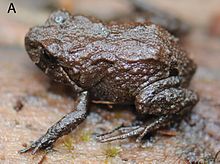Phrynopus
| Phrynopus | |
|---|---|
 |
|
| Phrynopus badius | |
| Scientific classification | |
| Kingdom: | Animalia |
| Phylum: | Chordata |
| Class: | Amphibia |
| Order: | Anura |
| Family: | Craugastoridae |
| Subfamily: | Holoadeninae |
| Genus: |
Phrynopus Peters, 1873 |
| Type species | |
|
Phrynopus peruanus Peters, 1873 |
|
| Diversity | |
| 26 species (see text) | |
Phrynopus is a genus of frogs of the Craugastoridae family. Their common name is Andes frogs. They are endemic to Peru and inhabit the upper humid montane forests and supra-treeline grasslands in the Cordillera Oriental, with one record from the Peruvian Cordillera Occidental.
The contents and phylogenetic position of Phrynopus have long been uncertain, and species once included in this genus have been moved to other genera (Bryophryne, Lynchius, Isodactylus (now Hypodactylus), Noblella, Niceforonia, and Psychrophrynella). Hedges and colleagues placed it in 2008 in Strabomantidae, subfamily Strabomantinae. Most recently, the genus was transferred into Craugastoridae, subfamily Holoadeninae. However, the AmphibiaWeb keeps Noblella in Strabomantidae/Strabomantinae, a family/subfamily no longer recognized by the Amphibian Species of the World.
Phrynopus are small to medium-sized frogs, from 14.5 mm (0.57 in) snout–vent length in Phrynopus auriculatus to 54 mm (2.1 in) in Phrynopus kauneorum. Head is narrower than the body. Differentiated tympanic membrane and tympanic annulus are usually absent, except in Phrynopus auriculatus and Phrynopus peruanus, two basal species. Dorsum is smooth to pustulate. Venter is smooth or areolate.
There are 26 species in this genus:
...
Wikipedia
